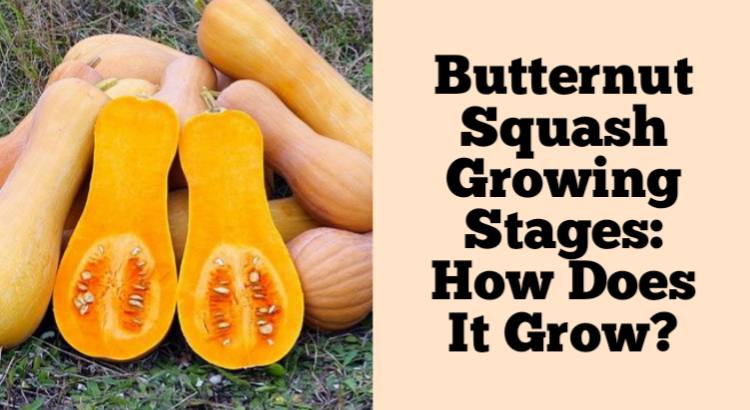Butternut Squash Growing Stages. Butternut squash (Cucurbita moschata) is being grown from seeds. The seeds will germinate and they will go into several stages of growth. The plants will appear, mature, and bears fruit. But how does butternut squash grow?
Butternut Squash Growing Stages
Stage 1. Seed
The seeds of butternut squash characteristics are small and flat, one edge is rounder and the other edge is pointed, flat, and white to brown in color.
The butternut squash can only be grown from seed and it cannot be propagated through cuttings, grafting, or other methods. The life cycle of butternut squash starts from the seed and without it, the plant will not grow.
When the seeds are high-quality they have more chances to germinate. There will be a high germination rate when good seeds are used in growing butternut squash.
Sowing the seeds in about 1 inch deep is good to make the seeds germinate faster.
Stage 2. Germination
With the right condition, the butternut squash seeds will germinate. It will take about 4 to 10 days for seeds to germinate. Commonly small seeds just like butternut squash seeds grow roots faster compared to plants with big seeds.
The butternut squash seeds need water in order to germinate. When the soil is too dry the seeds will not sprout. During the germination, a tiny root grows and tiny leaves emerge from the seeds.
When the butternut squash seeds are planted in the soil, you will see that something is coming out from the soil. After a few days, a small butternut squash plant will appear on the soil.
Stage 3. Seedling
A few days after the butternut squash seeds have been germinated, they will become seedlings. It will grow a thin stem, a few leaves, and more soft and short roots. During this time it will continue to increase in length.
The butternut squash seedlings need water and sunlight for them to grow well and increase in size. If the seedlings are planted in a seedling tray, they need to be transplanted.
When the seedlings have enough size and enough age (usually 10 to 15 days old or more) they can be moved into the garden. After transplanting the seedlings must be watered to keep them growing.
The butternut squash will grow vines in a matter of time.
Stage 4. Vegetative Growth
After a few weeks of growing the butternut squash plant will become longer and bigger. It will have many roots, and many leaves, the main stem is thicker and will grow longer vines.
Before butternut squash plants become more mature they must get enough water, nutrients, and sunlight. Those essential things will make the plants grow bigger and it’s important to make them grow flowers and fruits.
Care for the plant well to prevent problems like curling leaves, and yellowing leaves, and protect it from pests and diseases that may attack the plant. Using insecticidal soap can help to get rid of pests.
Butternut squash can grow on the soil but growing them on a trellis is also a good idea. Putting a trellis will help the plants grow better and make the fruits safer.
Letting the butternut squash grow on the soil is also good but growing them on a trellis can prevent diseases that may attack the fruits.
If butternut squashes are growing in the soil placing wood chips or straw will help to lessen the contact with the soil.
Stage 5. Flowering And Pollination
After a few weeks of growing butternut squash plants, they will start flowering. The flowers can appear on the plant as early as 35-40 days.
Usually, male butternut squash flowers appear first on the plant and the female flowers grow the next. There are also chances that the flowers may take a longer time to come. There will be more male flowers than female ones.
The male flower of butternut squash is just a flower while the female flower has a swollen part underneath the petals. Pollination is needed in order for the fruits to be produced.
Even though butternut has male and female flowers they still need the help of pollinators. Usually, butternut squash relies its pollination on the bees. But you can also do hand pollination to increase pollinated flowers on the butternut squash plant.
By using a small, dry brush you can move that pollen into several female flowers or by getting a male flower and brushing them into several flowers. When pollination is successful fruits will grow on the plant.
Stage 6. Fruiting
When pollination is successful, butternut squash plants will start growing fruits. It will take the plant around 90 to 120 days to grow and harvest squashes grown from seed.
There are times that some young butternut squashes are dropping. One reason why they drop is due to poor pollination.
When only a few flowers are pollinated, only a few squash fruits will grow and mature. So if you want more butternut squash growing on the plant, increase the pollinated flowers by doing hand pollination.
Also, keep the plants healthy by keeping pests and diseases in control.
The squashes are small in the early days but they slowly grow bigger and bigger until they mature. When the fruits have enough size ripe they can are ready to harvest.
The butternut squashes will also grow seeds inside the fruit which can be used again to grow new plants.
The Life Cycle Of Butternut Squash: Butternut Squash Growing Stages
The butternut squash life cycle is a series of stages where the plant grows from seed, becomes a seedling, grows bigger and longer, grows flowers, and eventually grows squashes.
The stages of growth of the butternut squash plant are going to be smoother and better when the plant receives enough sunlight for at least 6 to 8 hours, the right amount of water one inch of water per week, enough nutrients, and no pests and diseases attacking the plant.

